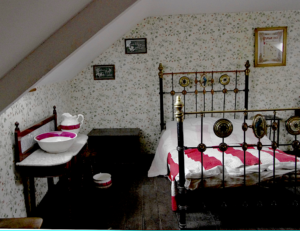Rows of terraced housing are typical of the Durham pit villages. As employment in the pits grew rapidly, there was a need for accommodation for the families of those working down the pits.
A row of six houses have been rebuilt here. Mining families were large and there could be as many as 12 people living in the house. The houses had a similar layout with a living kitchen to the rear with the coal fired range which provided heat, hot water and was also used for cooking. The front parlour was very much kept for ‘best’ but could also double up as a bedroom. Steps lead to the attic which provided extra sleeping accommodation for the children.
The houses had front gardens which were used to grow fruit and vegetables, with intense competition to see who could grow the largest leeks. Families also kept chickens and many men had pigeon lofts with pigeon fancying being a popular hobby.
The cottages also had a back lane giving access to the back yard, which contained the coal store (coal being provided free) and the earth closet. Next to each gate was a slate with the time for the ‘knocker up’ to make sure the menfolk were woken in time for their shift.
At the end of the terrace was a communal bread oven, important before the housewife had their own kitchen range.
Each of the houses is furnished differently. The end cottage is furnished as a mine office, with a brass plate on the door announcing Lambton Hetton and Joicey Collieries Ltd Office. No.2 is the home of a Methodist family with father and sons all working in the pit. They were comparatively well off and could afford good quality furniture. No.3 is is the home of a well off Irish Catholic immigrant family containing many items of value, which could be sold off in times of need. No 4 is the home of a miner’s widow, who is allowed to remain as her son also worked in the pit. Money was tight and the rooms are poorly furnished. The widow supplemented her income by taking in laundry and mending and by making quilts and rag mats. These were made from scraps of fabric. New mats were often used as a bed cover before going down for use as mats.
There are costumed interpreters in each of the cottages and it is worth talking to them to find out just what life was like.
This is one of a series of detailed “reviews”:https://www.silvertraveladvisor.com/travel-product/attraction/141741-beamish-open-air-museum I have written about Beamish.
A full account of my visits with all the pictures can be read “here.”:http://wasleys.org.uk/eleanor/presocialhistory/socialhistory/social/folkmuseums/beamish/index.html










